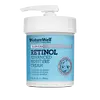What's inside
What's inside
 Key Ingredients
Key Ingredients

 Benefits
Benefits

 Concerns
Concerns

 Ingredients Side-by-side
Ingredients Side-by-side

Water
Skin ConditioningParaffinum Liquidum
EmollientCetearyl Alcohol
EmollientGlyceryl Stearate Se
EmulsifyingButylene Glycol Myristate
EmollientGlycerin
HumectantCeteareth-20
CleansingCaprylic/Capric Triglyceride
MaskingRetinol
Skin ConditioningTocopherol
AntioxidantAnthemis Nobilis Flower Extract
MaskingCamellia Sinensis Leaf Extract
AntimicrobialAloe Barbadensis Leaf Juice Powder
Skin ConditioningPhenoxyethanol
PreservativeCaprylyl Glycol
EmollientAcrylates/C10-30 Alkyl Acrylate Crosspolymer
Emulsion StabilisingTetrasodium Glutamate Diacetate
Sodium Hydroxide
BufferingIodopropynyl Butylcarbamate
PreservativeBHT
AntioxidantWater, Paraffinum Liquidum, Cetearyl Alcohol, Glyceryl Stearate Se, Butylene Glycol Myristate, Glycerin, Ceteareth-20, Caprylic/Capric Triglyceride, Retinol, Tocopherol, Anthemis Nobilis Flower Extract, Camellia Sinensis Leaf Extract, Aloe Barbadensis Leaf Juice Powder, Phenoxyethanol, Caprylyl Glycol, Acrylates/C10-30 Alkyl Acrylate Crosspolymer, Tetrasodium Glutamate Diacetate, Sodium Hydroxide, Iodopropynyl Butylcarbamate, BHT
Water
Skin ConditioningCocos Nucifera Oil
MaskingCaprylic/Capric Triglyceride
MaskingOctyldodecyl Myristate
EmollientDimethicone
EmollientGlycerin
HumectantPEG-8 Beeswax
EmulsifyingRetinol
Skin ConditioningMacadamia Ternifolia Seed Oil
EmollientVitis Vinifera Seed Oil
EmollientAllantoin
Skin ConditioningAscorbic Acid
AntioxidantRetinyl Palmitate
Skin ConditioningTocopheryl Acetate
AntioxidantGlyceryl Stearate
EmollientCetyl Alcohol
EmollientCeteth-20
CleansingSteareth-20
CleansingPolymethyl Methacrylate
Acrylates/Acrylamide Copolymer
MoisturisingPolysorbate 85
EmulsifyingTricaprylin
MaskingParaffinum Liquidum
EmollientBHT
AntioxidantPhenoxyethanol
PreservativeParfum
MaskingWater, Cocos Nucifera Oil, Caprylic/Capric Triglyceride, Octyldodecyl Myristate, Dimethicone, Glycerin, PEG-8 Beeswax, Retinol, Macadamia Ternifolia Seed Oil, Vitis Vinifera Seed Oil, Allantoin, Ascorbic Acid, Retinyl Palmitate, Tocopheryl Acetate, Glyceryl Stearate, Cetyl Alcohol, Ceteth-20, Steareth-20, Polymethyl Methacrylate, Acrylates/Acrylamide Copolymer, Polysorbate 85, Tricaprylin, Paraffinum Liquidum, BHT, Phenoxyethanol, Parfum
 Reviews
Reviews

Ingredients Explained
These ingredients are found in both products.
Ingredients higher up in an ingredient list are typically present in a larger amount.
BHT is a synthetic antioxidant and preservative.
As an antioxidant, it helps your body fight off free-radicals. Free-radicals are molecules that may damage your skin cells.
As a preservative, it is used to stabilize products and prevent them from degrading. Specifically, BHT prevents degradation from oxidation.
The concerns related to BHT come from oral studies; this ingredient is currently allowed for use by both the FDA and EU.
However, it was recently restricted for use in the UK as of April 2024.
Learn more about BHTThis ingredient is an emollient, solvent, and texture enhancer. It is considered a skin-softener by helping the skin prevent moisture loss.
It helps thicken a product's formula and makes it easier to spread by dissolving clumping compounds.
Caprylic Triglyceride is made by combining glycerin with coconut oil, forming a clear liquid.
While there is an assumption Caprylic Triglyceride can clog pores due to it being derived from coconut oil, there is no research supporting this.
Learn more about Caprylic/Capric TriglycerideGlycerin is already naturally found in your skin. It helps moisturize and protect your skin.
A study from 2016 found glycerin to be more effective as a humectant than AHAs and hyaluronic acid.
As a humectant, it helps the skin stay hydrated by pulling moisture to your skin. The low molecular weight of glycerin allows it to pull moisture into the deeper layers of your skin.
Hydrated skin improves your skin barrier; Your skin barrier helps protect against irritants and bacteria.
Glycerin has also been found to have antimicrobial and antiviral properties. Due to these properties, glycerin is often used in wound and burn treatments.
In cosmetics, glycerin is usually derived from plants such as soybean or palm. However, it can also be sourced from animals, such as tallow or animal fat.
This ingredient is organic, colorless, odorless, and non-toxic.
Glycerin is the name for this ingredient in American English. British English uses Glycerol/Glycerine.
Learn more about GlycerinParaffinum Liquidum is also known as liquid paraffin. It is a type of highly refined mineral oil.
Like other oils, Paraffinum Liquidum has emollient properties. Emollients help soothe and soften the skin. By creating a barrier to trap moisture within, emollients help keep your skin hydrated.
Paraffinum Liquidum does not irritate the skin and is non-comedogenic.
Learn more about Paraffinum LiquidumPhenoxyethanol is a preservative that has germicide, antimicrobial, and aromatic properties. Studies show that phenoxyethanol can prevent microbial growth. By itself, it has a scent that is similar to that of a rose.
It's often used in formulations along with Caprylyl Glycol to preserve the shelf life of products.
Retinol is a gold-standard ingredient for anti-aging. It is a form of Vitamin A and belongs to the class of retinoids that also includes tretinoin.
Why is retinol famous?
It has the most scientific studies backing up its skin benefits out of all the non-prescription ingredients.
Retinol is proven to:
This is why retinol is effective at removing wrinkles, fading dark spots, treating acne, and reducing the appearance of pores.
Studies show retinol is less effective when exposed to UV. Be sure to look for appropriate packaging to keep your retinol potent (similar to Vitamin C).
Using retinol or any retinoids will increase sun-sensitivity in the first few months. Though studies show retinoids increase your skin's natural SPF with continuous use, it is best to always wear sunscreen and sun-protection.
We recommend speaking with a medical professional about using this ingredient during pregnancy.
Retinol may cause irritation in some people, so be sure to patch test. Experts recommend 'ramping up' retinol use: start using this ingredient once a week and work up to using it daily.
Read about Tretinoin
Learn more about RetinolWater. It's the most common cosmetic ingredient of all. You'll usually see it at the top of ingredient lists, meaning that it makes up the largest part of the product.
So why is it so popular? Water most often acts as a solvent - this means that it helps dissolve other ingredients into the formulation.
You'll also recognize water as that liquid we all need to stay alive. If you see this, drink a glass of water. Stay hydrated!
Learn more about Water